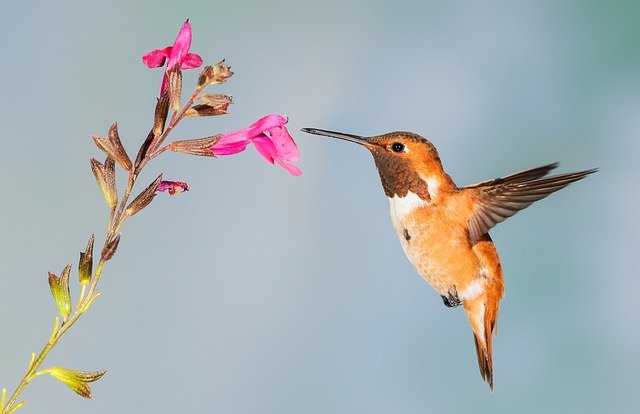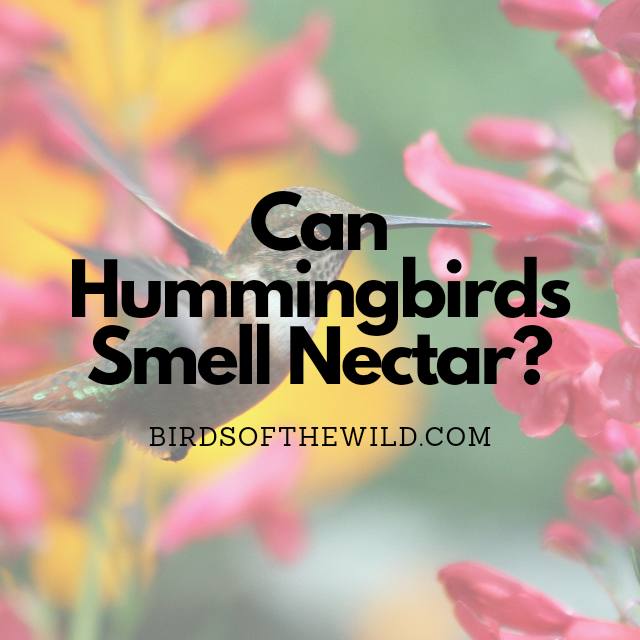Hummingbirds are among the most impressive avian species in the world. They are the smallest, produce the fastest wingbeat rate, and are the only bird species that can fly backward. These amazing skills mean that the hummingbird has an exceptionally high metabolism, seeking as many as 2000 flowers daily to satisfy their appetite.
To attract the hummingbird, many flowers produce sweet nectar for them to feed on. Continue reading to discover whether sight or smell draws the hummingbird to specific flowers and why some people believe that hummingbirds have no sense of smell at all.
Does Nectar Have A Recognisable Scent?
Flowers use nectar as an incentive for pollinators to visit; to attract these species, such as hummingbirds, flowers need a way to advertise the sweet treat on offer. This is why flowers often emit a scent; it lets passers-by know that nectar is present, giving them an incentive to visit.
However, “the scent of nectar” actually comes from the plant rather than the nectar itself. This is because nectar attracts herbivores as well as pollinators. Research from 2015 shows that the presence of nectar is one of the most significant determining factors for female moths looking for a place to lay their eggs.
If the larvae are allowed to hatch, they can cause devastation to the plant. Therefore, several flowers emit the scent of nectar but not the substance itself.
The primary ingredients of nectar include glucose, sucrose, and fructose, giving the substance a sweetness of between 8% and 50% (in comparison, Coca-Cola is 10%). In addition, nectar contains vitamins, amino acids, and oils. And some plants have added ingredients; one US tobacco plant adds bitter nicotine, which deters the feeder after a single sip, meaning they are more likely to visit multiple plants (and increase pollination).
Do Hummingbirds Have A Strong Sense Of Smell?

Google, “do hummingbirds have a strong sense of smell,” and you’re guaranteed to find a few sources claiming that these tiny birds cannot pick up scents. As the smallest bird in the world, everything about the hummingbird is tiny, including its olfactory bulbs. So, in the past, researchers found it challenging to prove that hummingbirds possessed any sense of smell.
But hummingbirds can smell. Research from the University of California in 2021 offered the first conclusive evidence that these tiny birds use scents to survive.
In the experiment, researchers set up two feeders; one contained only sugar water, and the other had sugar water with scents that signaled the presence of an insect. Aside from the differences in aroma, there was no visual way to tell the two containers apart. The results showed that hummingbirds actively avoided the container with traces of ant-derived chemicals.
This research challenges long-held beliefs about hummingbirds and suggests that they probably do use their sense of smell to seek out nectar-filled flowers.
Do Hummingbirds Use Their Sense Of Smell To Locate Other Foods?

Hummingbirds possess a significantly high metabolism, which means they must eat throughout the day to survive. With wings that beat up to 80 times per second, this incredible bird has evolved with a metabolism 77 times faster than a human being.
With such a high appetite, the hummingbird can consume half its body weight in food daily. This means they visit between 1000 and 2000 flowers daily while snacking on insects, ants, gnats, wasps, beetles, aphids, and mosquitoes.
Based on recent research, it’s highly probable that hummingbirds use their sense of smell to differentiate between different food sources. But, this is not the only sense they rely on.
Hummingbirds have an excellent sense of sight; they can see colors that we can only dream of, including ultraviolet yellow, green, and red. This incredible sense allows them to see a broader range of colors than us and helps them differentiate between many plants and insects.
The hummingbird is most attracted to red and yellow hues; red, in particular, is enticing thanks to it often signaling a rich food source. Studies prove this by showing that the cones in a hummingbird’s eye seem to heighten sensitivity to red and yellow while muting other colors like blue.
Still, this research also showed that the presence of nectar would most likely draw a bird to a specific flower. Based on this, it’s highly likely that hummingbirds also engage their sense of smell when seeking other food sources.
Summary
The hummingbird is one of the top pollinators thanks to its high metabolism and a healthy appetite. For this reason, many flower species are keen to attract these beautiful birds, and nectar is an excellent way to do it.
A hummingbird’s sense of sight may be better than its olfactory capabilities, though we still have more research to do on the latter before we can conclusively determine this. Either way, recent research suggests that nectar’s scent plays a significant role in attracting a hummingbird to a specific flower.
References
How flowers use scent and nectar to manipulate pollinators and herbivores (phys.org)
Nectar – Wikipedia
Hummingbirds can smell their way out of danger | NSF – National Science Foundation
Can Hummingbirds Smell? How These Birds Find A Feeder! (wildbirdscoop.com)
Wild hummingbirds see a broad range of colors humans can only imagine (princeton.edu)
Amhil Khan, a dedicated nature enthusiast and the founder of BirdsOfTheWild.com, is a passionate advocate for the captivating world of avian wonders. With a deep-seated curiosity about the intricate lives of birds, Amhil’s journey began as a fascination and has evolved into a mission to inspire others to appreciate and protect these magnificent creatures.
Amhil’s love for birds led to the creation of Birds of the Wild, a platform where his expertise in ornithology, coupled with his captivating storytelling, provides readers with an immersive and educational experience. Through his lens and words, he captures the essence of birds in their natural habitats, offering a glimpse into their behaviors, migrations, and the ecosystems they inhabit.

